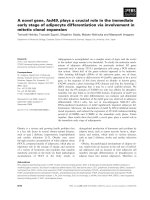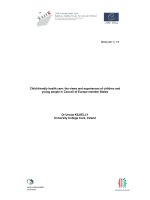- Trang chủ >>
- Khoa Học Tự Nhiên >>
- Vật lý
THE SURROUNDED ATOM THEORY OF ORDER DISORDER PHASE TRANSITION IN BINARY ALLOYS
Bạn đang xem bản rút gọn của tài liệu. Xem và tải ngay bản đầy đủ của tài liệu tại đây (90.75 KB, 7 trang )
Proc. Natl. Conf. Theor. Phys. 37 (2012), pp. 131-137
THE SURROUNDED ATOM THEORY OF ORDER-DISORDER
PHASE TRANSITION IN BINARY ALLOYS
DO CHIEU HA
Saigon University
NGUYEN NHAT KHANH
Department of Physics, University of Natural Sciences,
Ho Chi Minh City National University
Abstract. In this paper, the surrounded atom model is developed to study the order-disorder
phase transition in binary alloys. We calculate the configurational free energy of the alloys, derive
the equation of equilibrium and determine the critical temperature of the phase transition.
I. INTRODUCTION
Order-disorder transitions have been an active field of research over decades. The
first model for order- disorder transition in binary alloys was the Bragg-Williams model
[1-3], that suggested the existence of a long-range order parameter. In 1938 Kirkwood
presented a more general method by which the configurational free energy can be expanded
as a series in the long-range order parameter [3]. However, both Bragg-Williams and
Kirkwood models which incorporated only pair interactions predicted a higher transition
temperature and incorrect specific heat capacity above transition temperature [1-3]. The
numerical approaches have been proposed to take into account the other interactions and
fluctuations: ab-initio calculations, Monte Carlo simulations [5]. The studies of phase
transitions based on numerical methods have proved difficulties, especially when magnetic
orders and other interactions were taken into account. Therefore it is desired to develop
some simple analytical models, which can go beyond the pair interaction approximation.
In 1967 Bonnier et al proposed the surrounded atom model as a gereralization of the quasichemical method for calculating thermodynamic quantities of binary alloys [6]. Thus it is
meaningful to employ the surrounded atom model to study order-disorder phase transitions
in binary alloys.
In the present work we use the approach suggested by Bonnier et al for calculating
configurational free energy of binary alloys and obtaining the critical temperature and the
heat capacity at the critical temperature.
The paper is organized as follows. In Section II the formalism is introduced. The
configurational energy is calculated, then the critical temperature and the heat capacity
are determined. The discussions are presented in the final section, where we compared
our results with ones obtained by other known methods.
132
DO CHIEU HA AND NGUYEN NHAT KHANH
II. CONFIGURATIONAL FREE ENERGY AND ORDER PARAMETERS
Consider a binary order-disorder alloy with composition Am Bn having two kinds of
atoms A and B on a lattice. Let Z be the coordination number of the lattice, N - the
number of lattice sites and NA and NB - the number of A and B atoms, respectively.
Each A-site has ZAA nearest neighbours A-atoms and ZAB nearest neighbours B-atoms;
ZBB and ZBA are similarly defined. We define the quantities NAA , NBB and NBA to
be the number of nearest neighbours pairs of the AA, BB and AB type, respectively,
and we assume each pair has the interaction energy VAA , VAB and VBB , respectively, for
AA, AB and BB bond. At absolute zero temperature the alloy is completely ordered.
Suppose that the lattice of alloy on perfectly ordered state is devided into two sublattices
of labels a and b. Then the number of A atoms on a sites NAa is equal to NA and the
number of B atoms on b sites is equal to NB . At a given temperature, the free energy is a
minimum and a balance between the energy and the entropy is established so the crystal
is partially ordered and NAa < NA ; NBb < NB . The configuration of the system is defined
by numbering the lattice sites and specifying the type of atom on each site. For a given set
of occupation number {NAa , NBb } there are a great many distinguishable configurational
states. The long range order is measured by the parameter [1-3]:
f
− CA
(1)
η = Aa
1 − CA
where fAa means the fraction of A atoms in the a sublattices and Cα (α = A,B)is the
fraction of αatoms in the crystal. In this way η = 1 for the ordered phase and η = 0 for
the disordered phase.
Concerning the short-range correlations one introduces the short-range order parameter as [3].
q - q0
(2)
σ=
qm − q0
where q is the fraction of unlike bonds, qm (q0 ) is its maximum (minimum) value:
2
qm =
(NA NB + N2A )
2
N
2NA NB
(3)
q0 =
N2
Note that σ = 0 implies η = 0, however, η = 0 can correspond to σ = 0.
We define the average of some quantity on site α(α = A,B), the average being taken
over all configurational states, as follows:
Z
Wα (j)fα (j)
fα =
(4)
j=0
where Wα (j) is a probability of finding silmultaneously (Z − j)nearest α-atoms and j
unlike α-atoms surrounding a given αsite. We have
Z!
Wα (j) =
pZ−j pj
(5)
(Z - j)!j! αα αα
THE SURROUNDED ATOM THEORY OF ORDER-DISORDER PHASE TRANSITION ...
133
where pαα (pαα ) is the possibility of an α atom (unlike α- atom) being nearest neighbour
of a given αatom.
Let Vα (j) be the potential energy of an αatom having (Z − j)nearest-neighbour αatoms and j nearest-neighbour unlike α-atoms. According to Bonnier et al. [6], we assume
the following form for the α- atom potential:
Vα (j) = Vα (1 + a1 j + a2 j 2 )
(6)
where
Vα = Vα (j = 0)
(7)
Noting that VA (j) has a minimum at j = Z, one gets from (6):
j(2Z − j)
Vα (j) = Vα +
[Vα (Z) − Vα ]
(8)
Z2
We may interpret the formula (7) in a simple way.
When we replace Z atoms A surrounding the central atom A by Z atoms B, the
energy varies a quantity of VA (Z) − VA . This energy may be considered as the interaction
energy between Z pairs AA and Z pairs AB. The interaction energy between a pair AA
V (Z)−V
and Z pairs AB is equal to A Z A . The interaction energy between a pair AA and j
VA (Z)−VA
.j. The interaction energy
pairs AB is
Z2
VA (Z)−VA
between (Z − j)pairs AA and j pairs AB is
.j (Z − j) and (8) follows.
Z2
Substituting (8) into (4) one obtains the average potential of αatom in the form:
Vα = Vα +
(Vα (Z) − Vα )
Z
2 jα −
jα2
Z
(9)
The average values jα and jα2 are calculated according to (4) and may be written
in terms of the probability of finding a pair of unlike atoms pAB as follows
p
jα = Z AB
(10)
Cα
2
p
p
jα2 = Z AB + Z(Z − 1) AB
(11)
Cα
Cα
It is convenient to express the probability pAB in terms of the long-range order η
and the correlation factor εij
αα′ (i, j = a, b), which is defined in a standard way [2,3]. We
have
pAB = CA CB + bη 2 + εAB
(12)
where
b = CA CB (1 − CAA − CBB )
(13)
Zαα
N
ab
ab
+ CB CBB εbb
AB + CA CAB (εAB + εBA )
Cαα =
εAB = CA CAA εaa
AB
(14)
(15)
134
DO CHIEU HA AND NGUYEN NHAT KHANH
The configurational energy of the alloy is defined as
E = - [NA < VA > +NB < VB >]
and is derived from (9) – (10) to give:
E = -
(16)
NZ
(Z − 1)
β
p2 )]
.[CA VAA + CB VBB + ωpAB +
(ωpAB −
2
Z
CA CB AB
(17)
where
ω = 2VAB − VAA − VBB
β = VAB - CA VBB − CB VAA
(18)
(19)
The configurational free energy is
F = E − TS
(20)
We evaluate the entropy in two cases. First, we consider the system being in the
completely disordered phase with zero long-range order parameter. In this case one does
not distinguish a-site or b-site. The calculation is straightforward using the standard
method given in textbooks [3,4]:
S = - Nk{(1 - 2Z)(CA ln CA + CB lnCB )
+ Z[(CA − pAB )ln(CA − pAB ) + (CB − pAB )ln(CB − pAB ) + 2pAB lnpAB ]}
(21)
where k is the Boltzmann constant.
Using (17), (20) and (21) one obtains the configurational free energy for disordered
phase as follows:
F =−
NZ
CA VAA + CB VBB +
2
2Z − 1
Z
ωpAB −
Z−1
Z
β
p2
CA CB AB
+ N kT (1 − 2Z) (CA ln CA + CB ln CB )
(22)
+ Z (CA − pAB )ln(CA − pAB ) + (CB − pAB )ln(CB − pAB ) + 2pAB lnpAB
.
We note that when η = 0the pair probability pAB can be written in terms of
short-range order parameter σ as:
pAB = CA CB (1 − σ)
(23)
The quantities CA and CB are fixed while σ must be adjusted to minimize the
free energy. Differentiation of (22) with respect to σ gives the following equation for the
short-range order parameter:
ln
2
(C2
A − εAB )(CB − εAB )
(CA CB + εAB )2
Z−1
Z
=
1 + C εAB
A CB
kT
β+
1−2Z
2Z
ω
(24)
THE SURROUNDED ATOM THEORY OF ORDER-DISORDER PHASE TRANSITION ...
135
Now we derive the equilibrium equation for the long-range order parameter, when
the system is in the ordered state and the short range correlations can be neglected (εAB =
0). Following the method in [6], it is straightforward to evaluate the entropy. We find:
S = - Nk{νA (CA + νb η)ln(CA + νb η) + νa (CB − νb η)ln(CB − νb η)
+ νb (CB + νa η)ln(CB + νa η) + νb (CA − νa η)ln(CA − νa η)
(25)
Using (17), (20) and (25) one gets the configurational free energy for the ordered
state:
Z −1
NZ
{CA VAA + CB VBB +
(ω − β)CA CB
2
Z
(Z − 1)
(Z − 1)
β
+ bη 2 [ω +
b2 η 4 }
(ω − 2β)] −
.
Z
Z
CA CB
+ NkT{νA (CA + νb η)ln(CA + νb η) + νa (CB − νb η)ln(CB − νb η)
F =−
(26)
+ νB (CB + νa η)ln(CB + νa η) + νb (CA − νa η)ln(CA − νa η)
where
b = νA νb (1 − νaa − νbb )
and the equation for the long-range order parameter is given by:
(CA + νb η)(CB + νa η)
(CA − νa η)(CB − νb η)
Z −1
2(Z − 1)νa νb (1 − νaa − νbb )
Z(1 - νaa − νbb )
.βη 3 }
.{η[ω + (
)(ω − 2β)] −
=
kT
Z
ZCA CB
ln
(27)
The equations (17), (22), (24), (26) and (27) are the main results of the present
paper.
The theory presented above is remarkably general and valid for any type of lattice.
Once we have calculated the free energy and the order parameter equations, they provide
the way to obtain the phase transition critical temperature and the heat capacity given
a set of the crystal structure parameters. For the body-centered cubic lattice (β- brass
structure) we have:
1
CA = CB = ; CAA = CBB = 0
2
(28)
Z = 8; ZAA = Z=
BB 0
while for the face-centered cubic lattice
3
1
, CB =
4
4
Z = 12; ZAA = 0; ZAB = 12; ZBB = 8; ZBA = 4
(29)
For illustration we consider an AB alloy (e.g. β−brass). Using (28) the equation
(27) becomes:
CA =
ln(
1+η
4
7
)=
ηω(1 − η 2 )
1-η
kT
8
(30)
136
DO CHIEU HA AND NGUYEN NHAT KHANH
The critical temperature is determined by expanding the logarithms in series for
small η as follows:
4
7
η3
+ ... =
ηω(1 − η 2 )
3
kT
8
Letting η → 0, (31) gives the critical temperature for AB alloy:
2η +
(31)
kTC = 2ω
(32)
The heat capacity is the derivative of (17) with respect to temperature. Using (28),
it gives the jump in discontinuity in heat capacity at TC for AB alloys as
12
(33)
∆CV = N k
29
The temperature dependence of the order parameter may be computed from Eqs.
(30) and (32). Analogously , one can obtain the critical temperature and the heat capacity
for the face-centered cubic lattice, using equations (17), (27) and (29).
III. DISCUSSIONS
It is of interest to compare the above obtained values (32) and (33) with the ones
given by the various theories. In the Bragg-Williams approximation kTC = 2ω; ∆CV =
3
2 N k while in the Kirkwood theory kTC = 1,707ω; ∆CV = 2,207N k;in the quasichemical method kTC = 1,738ω [3,4]. Thus our results give the same value for TC as
the Bragg-Williams approximation does, but the jump in discontinuity in heat capacity is
smaller than the other theories. In the Bragg-Williams approximation the configurational
energy is given by [1-3]:
NZ
E0 = −
(CA VAA + CB VBB + pAB ω)
(34)
2
Comparing (34) with (17) one can see that the surrounded atom theory gives the
β
2
correction (Z−1)
Z (pAB ω − C C pAB ) for every bond to the Bragg-Williams energy due
A B
to the interactions between the bonds. Comparing with experiment our results as well
as the Bragg-Williams approximation reproduce the general feature of the order-disorder
transition. However, the experimental data show that the order-disorder contribution
to the heat capacity does not instantly vanish immediately above TC [2-3]. The BraggWilliams theory does not show a residual short-range order heat capacity above the critical
temperature, while the surrounded atom theory takes into account the short-range order
contribution (Eqs. (17) and (20)). The surrounded atom method clearly is an improvement
over the Bragg-Williams one, but not sufficiently so to yield the good agreement with
experiment.
There are several possible ways to improve the current work. The most obvious
one is to go beyond the nearest-neighbour approximation for the interaction energies. The
second one is to take into account the vibrational contribution to the free energy. The third
one concerns the calculation of the bond number. In the Bragg-Williams approximation
the site occupation probabilities are taken to be independent of each other. In our work,
THE SURROUNDED ATOM THEORY OF ORDER-DISORDER PHASE TRANSITION ...
137
as in the quasi-chemical approximation, this is improved somewhat by counting bonds,
but these bonds then considered to be independent.
ACKNOWLEDGEMENTS
The authors are grateful to Professor Nguyen Huu Minh (Hanoi National University
of Education) for the stimulating suggestions.
REFERENCES
[1]
[2]
[3]
[4]
[5]
[6]
[7]
W. L. Bragg and E. J. Williams, Proc. Roy. Soc. A145 (1934) 699.
T. Muto and Y. Takagi, Solid State Phys., F. Seitz and D. Turnbull (Eds.), 1 (1955) 193.
L. A. Girifalco, Statistical Mechanics of Solids, Oxford University Press, 2002.
F. Ducastell, Order and Phase Stability in Alloys, Elsevier Science, New York, 1991.
E. Bruno et al, Phys. Rev. B77 (2008) 155108 and references therein.
E. Bonnier et al, J. Chem. Phys., 64 (1967), 261; Adv. Phys. 63 (1967) 523.
Nguyen Huu Minh, J. Phys. 2 (1977) 8-14; 4 (1977) 24-27 (in Vietnamese).
Received 25 April 2012.









